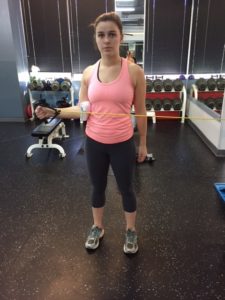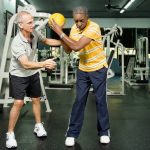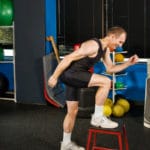 June 2024
June 2024
Fatness ——> Decreased Brain Fitness
A long-running argument exists in the health and fitness arena: can you be fat and be fit? Rather, can you have a body composition (BC) with excess fat and have good cardiovascular health if you exercise and eat well? Now they’ve ramped up the question to include the brain, not just heart, lung, kidney, and liver health.
A multi-center study tested the hypothesis that an exercise program designed to improve fitness and BC will also enhance structural brain health in older adults (65-84 y/o.) They had 225 exercisers doing 2/wk of 90- minute cardio and strength sessions for 6 months led by certified trainers. The non-exercisers served as controls. All participants had MRI scans of their brains pre- and post-study comparing gray matter, white matter, and cerebrospinal fluid changes to gauge BrainAge.

Gray and white matter volume changes are normal with age, with some studies demonstrating a protective effect from exercise in healthy and fit individuals. (I hope…) From this data, they could estimate brain-predicted age difference vs that of chronological-predicted age to yield what they call BrainPAD where a younger brain is a healthier brain.
As expected, the exercise group improved aerobic capacity, BC, and muscle mass, with a modest decline in visceral fat. However, it “did not appear to have a meaningful impact on BrainPAD.” Based on previous research by this group, a “clear association” exists between increased/faster-aging brains and increased fatness, especially visceral fatness. But this study’s results suggest that, at least in the short term, a healthy exercise regimen done twice/wk is not sufficient to effect favorable changes in the aging brain. Unless, of course, effort is made to reduce overall body fatness!
MSSE Apr. 2024
Love Your Shoulders, Especially After Surgery
Glenohumeral joint stabilization shoulder surgery, usually required after dislocation or subluxation of the ball and socket joint itself, requires extensive repairs of bony, ligamentous, and tendinous structures. The healing process is 3-4 months of progressive range of motion and strength exercises before which return to sport (RTS) is considered. A multi-center study compared surgically-repaired contact and collision athletes’ arm strength on several measures to an uninjured group looking for limb asymmetries and their association with different performance and strength variables.
Fifty-six male athletes who’d had the surgery were assessed on a force platform for symmetry of a double-arm task and on an isokinetic device for internal and external rotation strength from which comparisons to their uninjured limb could be made; 39 controls served as comparators for performance tests while 47 provided strength comparisons.
As one would expect, at 4 months post-surgery, the repaired limbs demonstrated substantial absolute interlimb asymmetries compared to the controls on all performance tests. In the ballistic upper-body tests – think, plyometric push ups – the surgical group achieved about half the power of the controls. By 6 months, however, the former had reduced the asymmetries for strength and ballistic performance tests but still had some deficits relative to their uninjured limb and their uninjured counterparts.
The authors concluded that shoulder stabilization surgery is very effective in getting athletes back in the game but that performance standards and safety might require a bit longer PT before they should RTS.
MSSE Jan. 2024
Tid Bits
Sitting, lying down, standing up, or moving about impact heart health. A European Heart Journal (Nov. 2023) report summarizing data from 6 earlier studies that included >15,000 people estimated that replacing 4-13 minutes of sitting with moderate-to-vigorous activity would improve heart health the most. Even shorter bursts of activity or just sleeping were associated with better heart health. Sitting is one health risk factor you can minimiz…zzzzz Harvard Women’s Health Watch Mar. 2024
The brain shrinks with age. Subjective cognitive decline (SCD) and mild cognitive impairment (MCI), especially if combined with cerebrovascular issues, can accelerate dementia onset. A study comparing Kundalini yoga (KY) and memory-enhancement training (MET: brain games) had a group of older women do a 1-hr class/wk + 12-minute home videos of KY daily for 12 weeks; the MET had a similar schedule for brain gaming. At the 12- and 24-wk follow-ups, they found there were “clinical and biological benefits to KY for SCD, linking changes in cognition to the anti-inflammatory effects of yoga.” Trans Psychiatry Feb. 2024
As we age, concerns for brain health come to the fore. A study (Int’l J of Behavioral Nutrition & Physical Activity, Nov. 2023) that looked at 473,000 adults enrolled in the UK Biobank tracked participants till they died, were diagnosed with dementia, Parkinson’s disease or depression, or the study ended. They found that how who reported watching 4+ hr/day of TV had a 28% higher risk of dementia, 35% higher risk of depression, and 16% higher risk of PD. Those who reported moderate (30-60 mins/day) amounts of computer use had lower risk of these disorders than those in the lowest levels of computer use. TVs don’t cause and computers don’t protect against dementia or PD, but their association with these disorders may be markers of something else going on. Harvard Women’s Health Watch Mar. 2024














